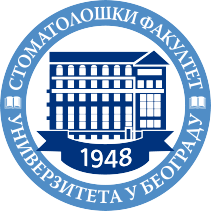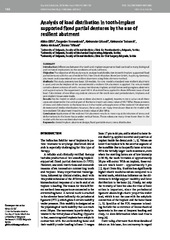Analysis of load distribution in tooth-implant supported fixed partial dentures by the use of resilient abutment
Analiza distribucije opterećenja kod mešovito nošenih mostova primenom rezilijentnih abatmenata
2016
Аутори
Glišić, MirkoStamenković, Dragoslav
Grbović, Aleksandar

Todorović, Aleksandar
Marković, Aleksa

Trifković, Branka

Чланак у часопису (Објављена верзија)
Метаподаци
Приказ свих података о документуАпстракт
Introduction Differences between the tooth and implant response to load can lead to many biological and technical implications in the conditions of occlusal forces. Objective The objective of this study was to analyze load distribution in tooth/implant-supported fixed partial dentures with the use of resilient TSA (Titan Shock Absorber, BoneCare GmbH, Augsburg, Germany) abutment and conventional non-resilient abutment using finite element method. Methods This study presents two basic 3D models. For one model a standard non-resilient abutment is used, and on the implant of the second model a resilient TSA abutment is applied. The virtual model contains drawn contours of tooth, mucous membranes, implant, cortical bones and spongiosa, abutment and suprastructure. The experiment used 500 N of vertical force, applied in three different cases of axial load. Calculations of von Mises equivalent stresses of the tooth root and periodontium, implants and peri-implant tissue were made. Results Fo...r the model to which a non-resilient abutment is applied, maximum stress values in all three cases are observed in the cortical part of the bone (maximum stress value of 49.7 MPa). Measurements of stress and deformation in the bone tissue in the model with application of the resilient TSA abutment demonstrated similar distribution; however, these values are many times lower than in the model with non-resilient TSA abutment (maximum stress value of 28.9 MPa). Conclusion Application of the resilient TSA abutment results in more equal distribution of stress and deformations in the bone tissue under vertical forces. These values are many times lower than in the model with the non-resilient abutment.
Uvod Razlike u odgovoru zuba i implantata na opterećenje mogu imati za posledicu niz bioloških i tehničkih komplikacija u uslovima delovanja okluzalnih sila. Cilj rada Cilj ovog rada je da se analizira distribucija opterećenja kod mešovito nošenih mostova sa primenom rezilijentnog TSA abatmenta (Titan Shock Absorber, BoneCare GmbH Germany), kao i konvencionalnog nerezilijentnog abatmenta primenom metode konačnih elemenata (MKE). Metode rada U ovom radu napravljena su dva osnovna 3D modela. Na jednom implantatu i modelu korišćen je standardni nerezilijentni abatment, a na implantatu drugog modela korišćen je rezilijentni TSA abatment. Na virtuelnom modelu su modelirane konture zuba, PDL-a, sluzokože, implantata, kortikalne i spongiozne kosti, abatmenta i suprastrukture. U eksperimentu je korišćena vertikalna sila od 500 N, koja je primenjena u tri različita slučaja aksijalnog opterećenja. Metodom konačnih elemenata izračunavani su potom Fon Mizesovi ekvivalentni naponi u korenu zuba i p...arodoncijumu, implantatu i periimplantatnom tkivu. Rezultati Na modelu kod koga je primenjen nerezilijentni abatment, maksimalne vrednosti napona i deformacije u sva tri slučaja su registrovane u kortikalnom delu kosti oko zuba i implantata u zavisnosti od napadne tačke sile (maksimalan napon 49,7 MPa). Vrednosti napona i deformacija na modelu sa primenom rezilijentnog TSA abatmenta pokazale su sličnu raspodelu u kosti, međutim ove vrednosti su višestruko manje nego kod modela sa nerezilijentnim abatmentom (maksimalan napon 28,9 MPa). Zaključak Primena rezilijentnog TSA abatmenta dovodi do ravnomernije raspodele napona i deformacije u koštanom tkivu oko zuba i implantata pod dejstvom vertikalnih sila. Izmerene vrednosti su višestruko manje nego na modelu sa nerezilijentnim abatmentom.
Кључне речи:
dental implant-abutment design / fixed partial denture / stress distribution / implant abatment / most / distribucija naponaИзвор:
Srpski arhiv za celokupno lekarstvo, 2016, 144, 3-4, 188-195Издавач:
- Srpsko lekarsko društvo, Beograd
DOI: 10.2298/sarh1604188G
ISSN: 0370-8179
WoS: 000378019800008
Scopus: 2-s2.0-84969795569
Колекције
Институција/група
Stomatološki fakultetTY - JOUR AU - Glišić, Mirko AU - Stamenković, Dragoslav AU - Grbović, Aleksandar AU - Todorović, Aleksandar AU - Marković, Aleksa AU - Trifković, Branka PY - 2016 UR - https://smile.stomf.bg.ac.rs/handle/123456789/2159 AB - Introduction Differences between the tooth and implant response to load can lead to many biological and technical implications in the conditions of occlusal forces. Objective The objective of this study was to analyze load distribution in tooth/implant-supported fixed partial dentures with the use of resilient TSA (Titan Shock Absorber, BoneCare GmbH, Augsburg, Germany) abutment and conventional non-resilient abutment using finite element method. Methods This study presents two basic 3D models. For one model a standard non-resilient abutment is used, and on the implant of the second model a resilient TSA abutment is applied. The virtual model contains drawn contours of tooth, mucous membranes, implant, cortical bones and spongiosa, abutment and suprastructure. The experiment used 500 N of vertical force, applied in three different cases of axial load. Calculations of von Mises equivalent stresses of the tooth root and periodontium, implants and peri-implant tissue were made. Results For the model to which a non-resilient abutment is applied, maximum stress values in all three cases are observed in the cortical part of the bone (maximum stress value of 49.7 MPa). Measurements of stress and deformation in the bone tissue in the model with application of the resilient TSA abutment demonstrated similar distribution; however, these values are many times lower than in the model with non-resilient TSA abutment (maximum stress value of 28.9 MPa). Conclusion Application of the resilient TSA abutment results in more equal distribution of stress and deformations in the bone tissue under vertical forces. These values are many times lower than in the model with the non-resilient abutment. AB - Uvod Razlike u odgovoru zuba i implantata na opterećenje mogu imati za posledicu niz bioloških i tehničkih komplikacija u uslovima delovanja okluzalnih sila. Cilj rada Cilj ovog rada je da se analizira distribucija opterećenja kod mešovito nošenih mostova sa primenom rezilijentnog TSA abatmenta (Titan Shock Absorber, BoneCare GmbH Germany), kao i konvencionalnog nerezilijentnog abatmenta primenom metode konačnih elemenata (MKE). Metode rada U ovom radu napravljena su dva osnovna 3D modela. Na jednom implantatu i modelu korišćen je standardni nerezilijentni abatment, a na implantatu drugog modela korišćen je rezilijentni TSA abatment. Na virtuelnom modelu su modelirane konture zuba, PDL-a, sluzokože, implantata, kortikalne i spongiozne kosti, abatmenta i suprastrukture. U eksperimentu je korišćena vertikalna sila od 500 N, koja je primenjena u tri različita slučaja aksijalnog opterećenja. Metodom konačnih elemenata izračunavani su potom Fon Mizesovi ekvivalentni naponi u korenu zuba i parodoncijumu, implantatu i periimplantatnom tkivu. Rezultati Na modelu kod koga je primenjen nerezilijentni abatment, maksimalne vrednosti napona i deformacije u sva tri slučaja su registrovane u kortikalnom delu kosti oko zuba i implantata u zavisnosti od napadne tačke sile (maksimalan napon 49,7 MPa). Vrednosti napona i deformacija na modelu sa primenom rezilijentnog TSA abatmenta pokazale su sličnu raspodelu u kosti, međutim ove vrednosti su višestruko manje nego kod modela sa nerezilijentnim abatmentom (maksimalan napon 28,9 MPa). Zaključak Primena rezilijentnog TSA abatmenta dovodi do ravnomernije raspodele napona i deformacije u koštanom tkivu oko zuba i implantata pod dejstvom vertikalnih sila. Izmerene vrednosti su višestruko manje nego na modelu sa nerezilijentnim abatmentom. PB - Srpsko lekarsko društvo, Beograd T2 - Srpski arhiv za celokupno lekarstvo T1 - Analysis of load distribution in tooth-implant supported fixed partial dentures by the use of resilient abutment T1 - Analiza distribucije opterećenja kod mešovito nošenih mostova primenom rezilijentnih abatmenata VL - 144 IS - 3-4 SP - 188 EP - 195 DO - 10.2298/sarh1604188G ER -
@article{
author = "Glišić, Mirko and Stamenković, Dragoslav and Grbović, Aleksandar and Todorović, Aleksandar and Marković, Aleksa and Trifković, Branka",
year = "2016",
abstract = "Introduction Differences between the tooth and implant response to load can lead to many biological and technical implications in the conditions of occlusal forces. Objective The objective of this study was to analyze load distribution in tooth/implant-supported fixed partial dentures with the use of resilient TSA (Titan Shock Absorber, BoneCare GmbH, Augsburg, Germany) abutment and conventional non-resilient abutment using finite element method. Methods This study presents two basic 3D models. For one model a standard non-resilient abutment is used, and on the implant of the second model a resilient TSA abutment is applied. The virtual model contains drawn contours of tooth, mucous membranes, implant, cortical bones and spongiosa, abutment and suprastructure. The experiment used 500 N of vertical force, applied in three different cases of axial load. Calculations of von Mises equivalent stresses of the tooth root and periodontium, implants and peri-implant tissue were made. Results For the model to which a non-resilient abutment is applied, maximum stress values in all three cases are observed in the cortical part of the bone (maximum stress value of 49.7 MPa). Measurements of stress and deformation in the bone tissue in the model with application of the resilient TSA abutment demonstrated similar distribution; however, these values are many times lower than in the model with non-resilient TSA abutment (maximum stress value of 28.9 MPa). Conclusion Application of the resilient TSA abutment results in more equal distribution of stress and deformations in the bone tissue under vertical forces. These values are many times lower than in the model with the non-resilient abutment., Uvod Razlike u odgovoru zuba i implantata na opterećenje mogu imati za posledicu niz bioloških i tehničkih komplikacija u uslovima delovanja okluzalnih sila. Cilj rada Cilj ovog rada je da se analizira distribucija opterećenja kod mešovito nošenih mostova sa primenom rezilijentnog TSA abatmenta (Titan Shock Absorber, BoneCare GmbH Germany), kao i konvencionalnog nerezilijentnog abatmenta primenom metode konačnih elemenata (MKE). Metode rada U ovom radu napravljena su dva osnovna 3D modela. Na jednom implantatu i modelu korišćen je standardni nerezilijentni abatment, a na implantatu drugog modela korišćen je rezilijentni TSA abatment. Na virtuelnom modelu su modelirane konture zuba, PDL-a, sluzokože, implantata, kortikalne i spongiozne kosti, abatmenta i suprastrukture. U eksperimentu je korišćena vertikalna sila od 500 N, koja je primenjena u tri različita slučaja aksijalnog opterećenja. Metodom konačnih elemenata izračunavani su potom Fon Mizesovi ekvivalentni naponi u korenu zuba i parodoncijumu, implantatu i periimplantatnom tkivu. Rezultati Na modelu kod koga je primenjen nerezilijentni abatment, maksimalne vrednosti napona i deformacije u sva tri slučaja su registrovane u kortikalnom delu kosti oko zuba i implantata u zavisnosti od napadne tačke sile (maksimalan napon 49,7 MPa). Vrednosti napona i deformacija na modelu sa primenom rezilijentnog TSA abatmenta pokazale su sličnu raspodelu u kosti, međutim ove vrednosti su višestruko manje nego kod modela sa nerezilijentnim abatmentom (maksimalan napon 28,9 MPa). Zaključak Primena rezilijentnog TSA abatmenta dovodi do ravnomernije raspodele napona i deformacije u koštanom tkivu oko zuba i implantata pod dejstvom vertikalnih sila. Izmerene vrednosti su višestruko manje nego na modelu sa nerezilijentnim abatmentom.",
publisher = "Srpsko lekarsko društvo, Beograd",
journal = "Srpski arhiv za celokupno lekarstvo",
title = "Analysis of load distribution in tooth-implant supported fixed partial dentures by the use of resilient abutment, Analiza distribucije opterećenja kod mešovito nošenih mostova primenom rezilijentnih abatmenata",
volume = "144",
number = "3-4",
pages = "188-195",
doi = "10.2298/sarh1604188G"
}
Glišić, M., Stamenković, D., Grbović, A., Todorović, A., Marković, A.,& Trifković, B.. (2016). Analysis of load distribution in tooth-implant supported fixed partial dentures by the use of resilient abutment. in Srpski arhiv za celokupno lekarstvo Srpsko lekarsko društvo, Beograd., 144(3-4), 188-195. https://doi.org/10.2298/sarh1604188G
Glišić M, Stamenković D, Grbović A, Todorović A, Marković A, Trifković B. Analysis of load distribution in tooth-implant supported fixed partial dentures by the use of resilient abutment. in Srpski arhiv za celokupno lekarstvo. 2016;144(3-4):188-195. doi:10.2298/sarh1604188G .
Glišić, Mirko, Stamenković, Dragoslav, Grbović, Aleksandar, Todorović, Aleksandar, Marković, Aleksa, Trifković, Branka, "Analysis of load distribution in tooth-implant supported fixed partial dentures by the use of resilient abutment" in Srpski arhiv za celokupno lekarstvo, 144, no. 3-4 (2016):188-195, https://doi.org/10.2298/sarh1604188G . .



